In 1975 the New Mexico DMV implemented a general redesign and reissue of
virtually all types of non-passenger plates. Consequently, the plates in
use during 1974 could not be renewed, making it necessary to
obtain new plates which were uniformly red on yellow and—depending on
type—bore an embossed “75,” embossed “1975,” or in some cases, an
embossed “19” in the lower left corner and an embossed “75” in the lower
right corner.
The various Official plates (OF, XC, XM, HD, US, State Police, etc.)
underwent only subtle revisions and retained their
maroon-on-reflective-blue colors. These plates, therefore, are not
covered in this discussion.
New Mexico’s 1975 plates were illustrated and described in an MVD
pamphlet entitled Department of Motor Vehicles 1975 License Plates
and Stickers, Jerry Manzagol, Commissioner (DMV-P001, Feb ’75). A
statement on the cover explained that “License plates issued with
abbreviated New Mexico (N.M.) at top left of license plate with large
blank area at the top center of license plate is reserved for future
county name sticker.” As far as is known, however, no
county name stickers were made available for these plates, and such
stickers apparently did not come into use until plates were manufactured
with a debossed sticker box at top center in 1977. (A very few
plates were manufactured with this sticker box in late 1976, with vanity
plates being such an example, and occasionally a 1975 base plate will be
found with a county name sticker that was applied during a later renewal
year.)
In general, the new design employed an embossed “N.M.” in the top left
corner, a large blank space across the top, embossed “LAND OF
ENCHANTMENT” across the bottom and an embossed “75” in the lower right
corner. The colors were standardized to red on yellow. There was slight
deviation in layout for Amateur Radio, Consular Corps and Vanity plates,
with these differences given in the individual descriptions below.
The aforementioned DMV publication also reports the range of serial
numbers issued for most types of the redesigned plates. Because the
pamphlet was released in February of 1975, we can infer that these
serial numbers likely represented what had been manufactured up to the
publication date, and as such would have been greater in number by the
end of the year. In fact, a later MVD publication, New Mexico
License Plates 1984 Edition, gives totals for the numbers of
several types of plates made in the initial 1975 style, as well as for a
succeeding style which also carried an embossed “75” date. Where they
are given in the pamphlet, we supply the 1975 serial number ranges with
each type illustrated below, and one can refer to the 1975 section of
the Varieties page for
the grand totals produced in this style before the switch was made to
the secondary style.
The original 1975 design illustrated and discussed on this page was
actually short-lived. All types of plates shown here were soon
redesigned again, many within two years. The style that followed
retained the same serial number formats, the red-on-yellow colors and
even an embossed “75,” but the raised border was eliminated. Perhaps the
most significant feature of the follow-on design was that for the first
time recessed “sticker boxes” were incorporated—a small
one in the lower right corner for the annual revalidation sticker, and a
larger one along the top edge for the new county name stickers.
These two varieties of 1975 base plates, for a half dozen non-passenger
types, are shown for comparison in the 1975 section of the
Varieties
page. Together they were a harbinger of things to come, for they defined
the fundamental characteristics of most of New Mexico’s license plates
from that point on. Some of the redesigned 1975 non-passenger
plates are known to have also been issued in Sample form. Those which
have been photographically documented can be seen in the non-passenger
section of the Samples page.
|
| |
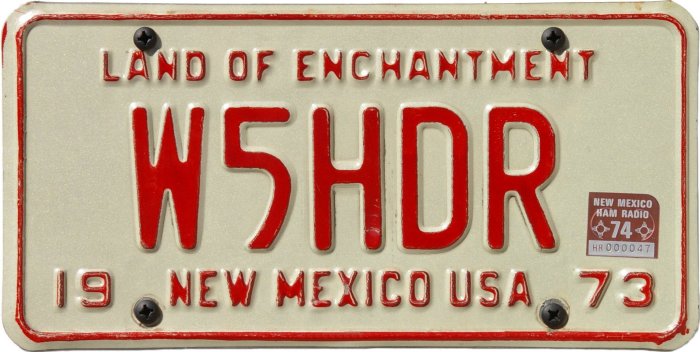
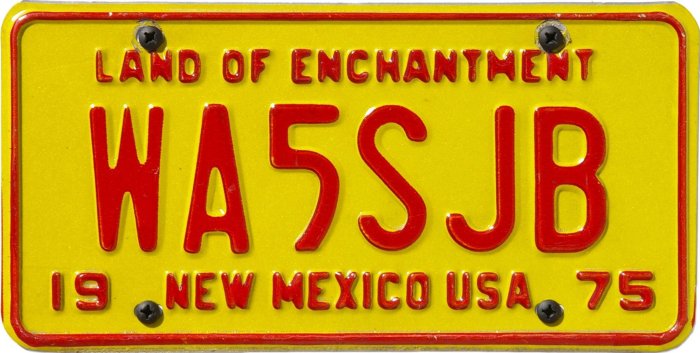 |
| |
| Amateur Radio plates for 1974
were red on reflective white, with most of them being a 1973 base with a
1974 “HAM RADIO” sticker. The redesigned 1975 version replicated the
date arrangement from the previous year with “19” in the lower left
corner and “75” in the lower right corner. Other than Amateur Radio,
only Consular Corps and Vanity plates displayed the date in this fashion
in the new design. For more information on this type, please see the
Amateur Radio page. |
| |
| |
.JPG)
.JPG) |
| |
| Commercial Bus tags during
1971–1974 used the white-on-reflective-green 1971 base, revalidated in
the following years with “BUS” stickers. While the serial number format
remained unchanged, the plate was otherwise completely revamped in the
new red-on-yellow color scheme for 1975. The only series shown to have
been issued for 1975 was CB-0001 to CB-0800. For more information on
this type, please see the Commercial
Bus page. |
| |
| |
.jpg)
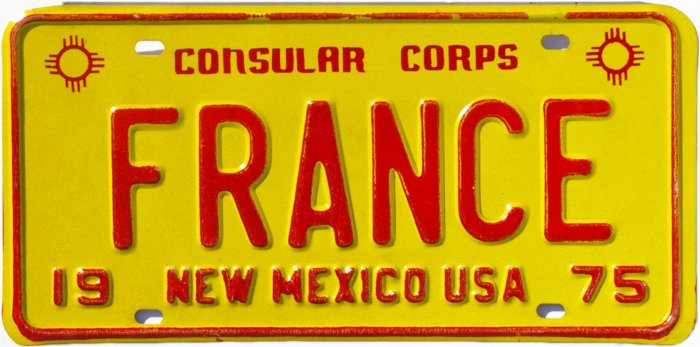 |
| |
| Consular Corps license plates
were always very few in number, issued for only a few years in the
1970s, and for only a few countries. The redesigned 1975 version was
identical to the prior year layout, changing only the
red-on-reflective-white color to the new red on yellow. For more
information on this type, please see the
Consular Corps page. |
| |
| |
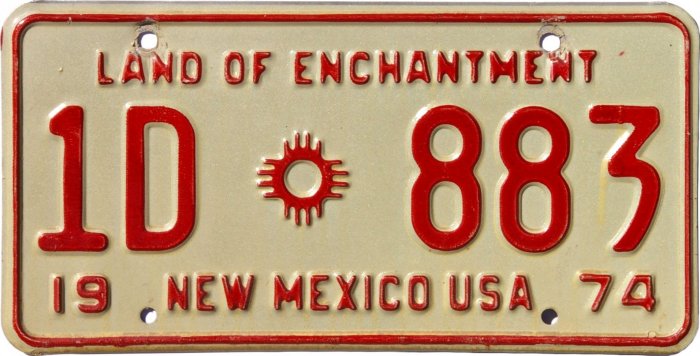
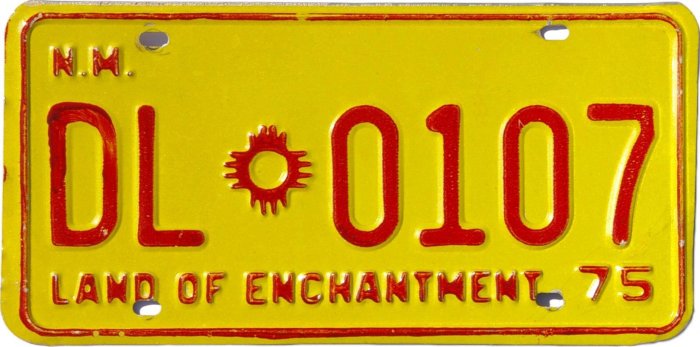 |
| |
| Dealer plates since at least
the 1930s used a numbering scheme whereby any dealer requesting more
than one plate received plates numbered as follows: The first plate was
numbered D-000, where 000 was a unique number assigned to the specific
dealer. Subsequent plates were then numbered 1D-000, 2D-000, 3D-000, and
so forth. The 1975 redesign dispensed with this system entirely, and all
plates received by all dealers, regardless of number requested (or when
in the year they were requested), had serial numbers of the format
DL-0000. This greatly simplified the issuance of Dealer plates since
they could be manufactured in advance and in bulk, without having to
know which dealers would be requesting plates, or in what quantity. The
1975 DMV pamphlet stated that the serial numbers of the new plates
issued were DL-0001 to DL-4999. For more information on this type,
please see the Dealer page. |
| |
| |
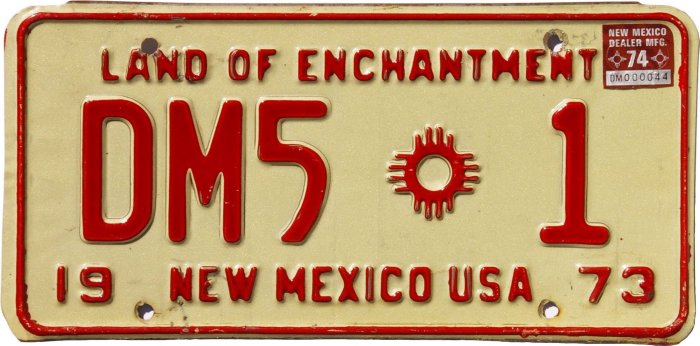
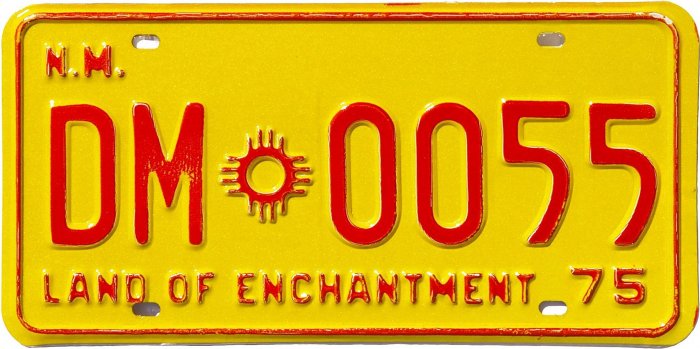 |
| |
| Dealer Manufacturer tags as a
New Mexico type were exceptionally few in number, and the DMV reported
that the newly designed plates for 1975 were numbered only from DM-0001
to DM-0040. As seen above, the 1975 DM plates were in the new standard
red-on-yellow colors, and with a new serial number configuration similar
to that of regular Dealer plates. For more information on this type,
please see the Dealer Manufacturer
page |
| |
| |
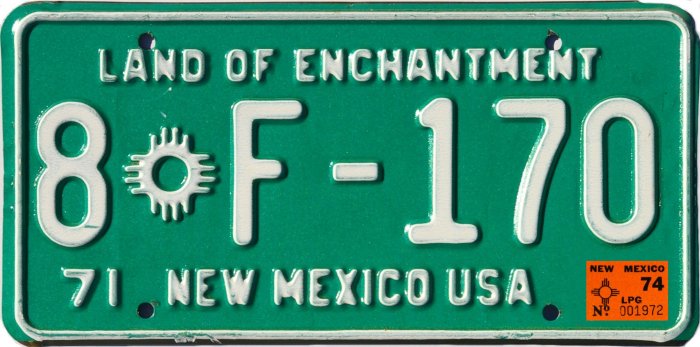
.JPG) |
| |
| Farm Truck. This type had been
introduced in 1956, and by 1974 was still using the same general serial
number format initiated in the beginning, including the county code
designator which Passenger car plates had dropped two years earlier. Its
colors mirrored those of regular Truck plates, which in 1971–1974 used
the white-on-reflective-green 1971 base, revalidated in the following
years with “TRUCK” stickers (or, as in the example pictured above, LPG
stickers). The 1975 revision represented a major change in design.
The county code was eliminated, and in its place was a serial number
arrangement of FT-0000 on the new red-on-yellow colors. MVD reported a
serial number range of FT-0001 to FT-4000. For more information on this
type, please see the Farm Truck
page. |
| |
| |
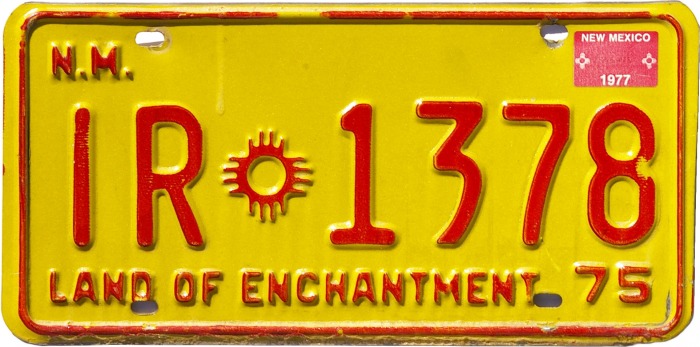 |
| |
| Interstate, or IR, plates are
not known to have been issued prior to 1975 and therefore we have no
earlier examples to compare them to. These plates for 1975 conformed to
the new non-passenger design and colors, using an IR prefix in the
serial number, with the MVD reporting as issued IR-0001 to IR-3000. For
more information on this type, please see the
Apportioned/Interstate page. |
| |
| |
.JPG)
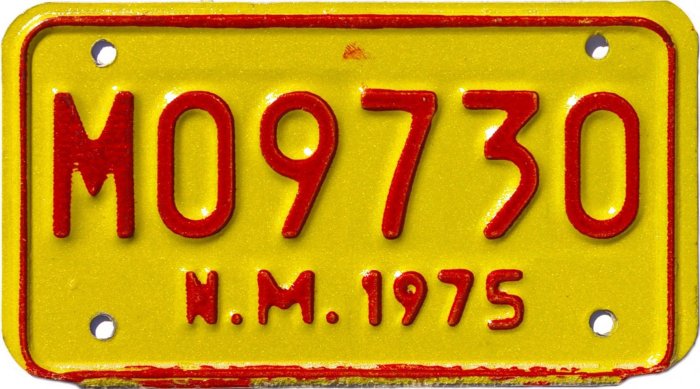 |
| |
| Motorcycle license plates were
in the same colors as Passenger car plates 1913-1959, then for some
years through 1971 had unique colors of their own, and in other years
colors of Trailer and/or Truck plates. In 1972 they reverted to the
then-Passenger car colors of red on reflective white, with the 1974
issues being a 1973 base validated with a 1974 sticker. The 1975
redesign brought about the color change to red on yellow, with the
designation “N.M. 1975” at the bottom, a format first put into use in
late 1966 when the current 4" x 7" size was introduced. The 1975 issue
also continued the practice implemented about 1973 of using leading
zeroes in place of blank spaces or a hyphen for serial numbers with
fewer than five digits. Serial numbers prepared for issue in 1975 were
M00001 to M29000. For more information on this type, please see the
Motorcycle page. |
| |
| |
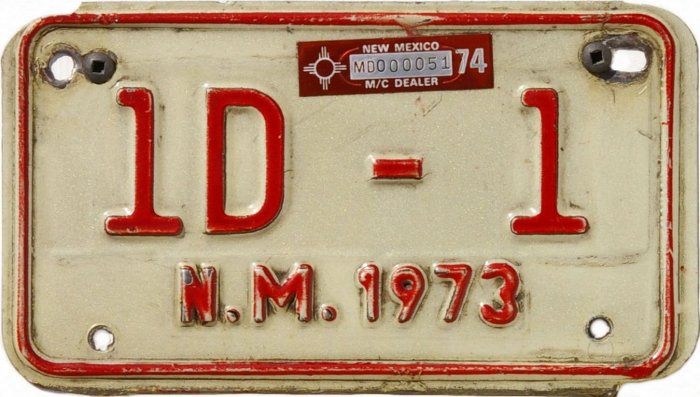
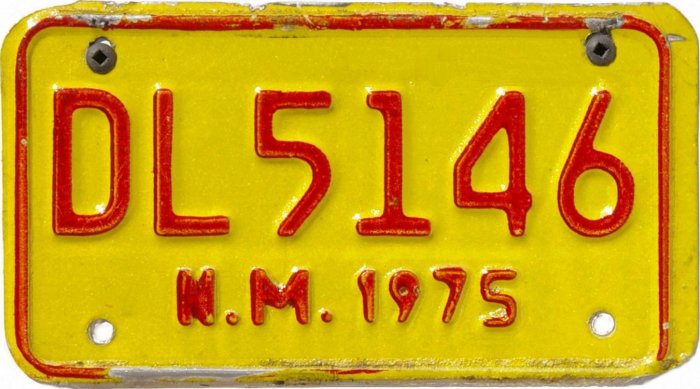 |
| |
| Motorcycle Dealer plates
through 1974 used a serial number format identical to that on regular
Dealer plates except for a hyphen appearing in place of the zia symbol.
The 1975 redesign changed this format to be identical to that as on
regular Dealer plates, but omitted the zia symbol, i.e., DL0000. The
serial number range was DL5000 to DL5200, chosen so as to avoid any
duplication of regular Dealer plates which ran DL-0001 to DL-4999. For
more information on this type, please see the
Motorcycle Dealer
page. |
| |
| |
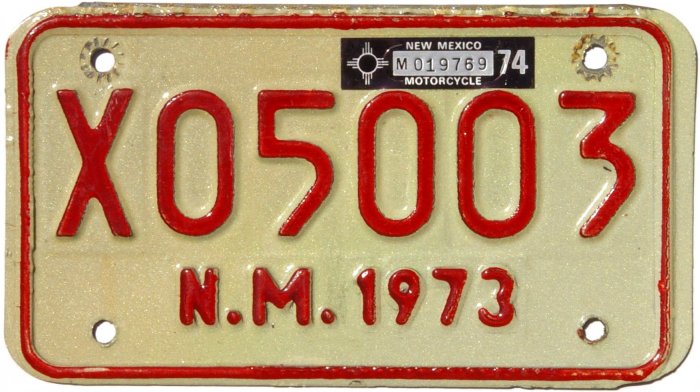
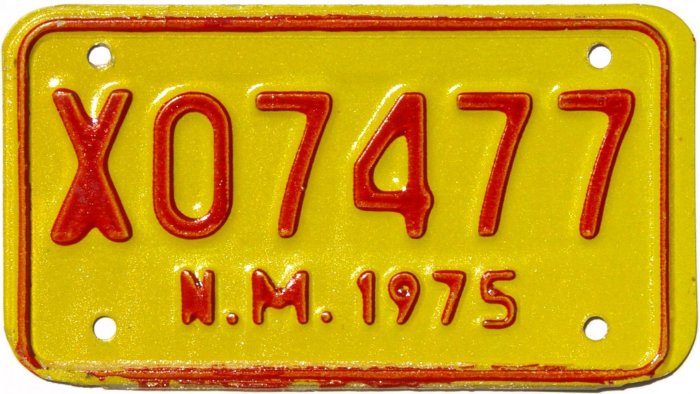 |
| |
| Motorcycle X-prefix was a
special classification introduced in 1971 for small bikes of 5 H.P. or
less. By 1978 the basis for the classification was changed from a power
rating to an engine displacement rating, with motorcycles coming in at
100 cc or less receiving the X-prefix plates. From 1971 through 1974 the
colors and other characteristics of these plates mirrored those of
regular Motorcycle plates, excepting, of course, the use of the “X” in
place of the “M.” For 1975 the serial number range was given as X00001
to X10000. For more information on this type, please see the
Motorcycle X-prefix
page. |
| |
| |

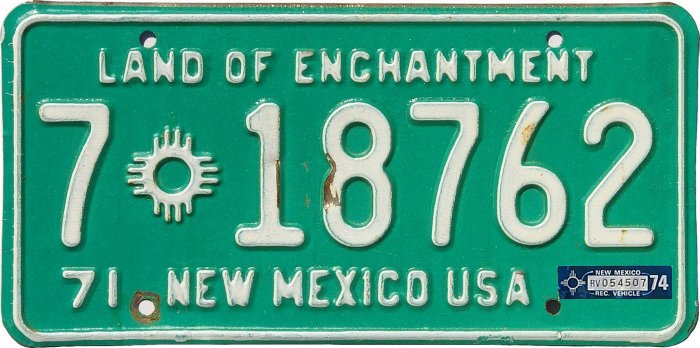
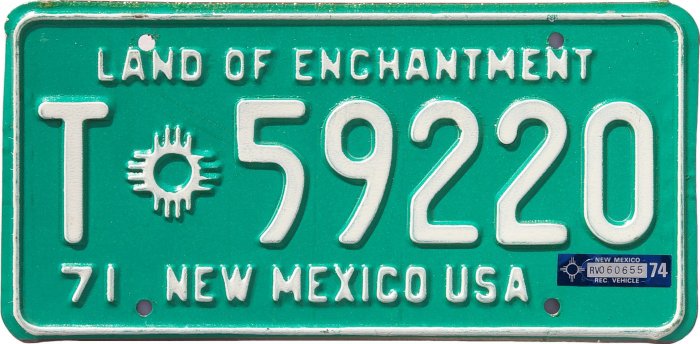
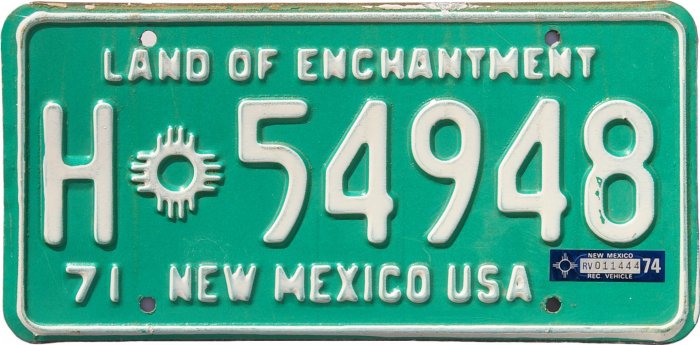
.JPG) |
| |
| Recreational Vehicle is a type
introduced in 1974 as a special REC VEHICLE sticker on 1971 base Truck, Trailer
and House Trailer plates. The 1975 redesign brought this type into its
own with purpose-made red-on-yellow RV plates using a stacked “RV” as a
prefix to the serial number which continued with a single alpha
character followed by the zia symbol and four numeric digits. The 1975
MVD pamphlet reports that following serials were made available for
issue that year: RVA-0001 to RVA-9999, and the same for RVB, RVC, RVD,
RVE and RVF. For more information on this type, please see the
Recreational Vehicle
page. |
| |
| |
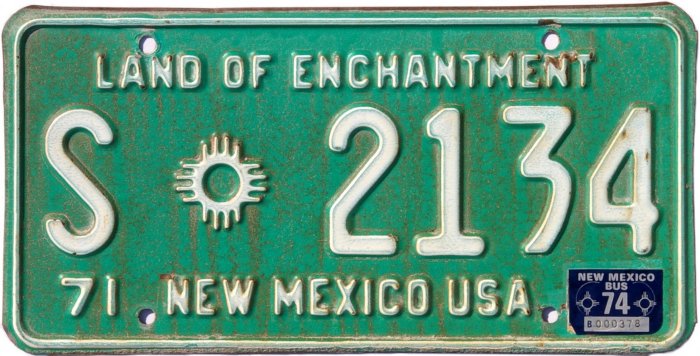
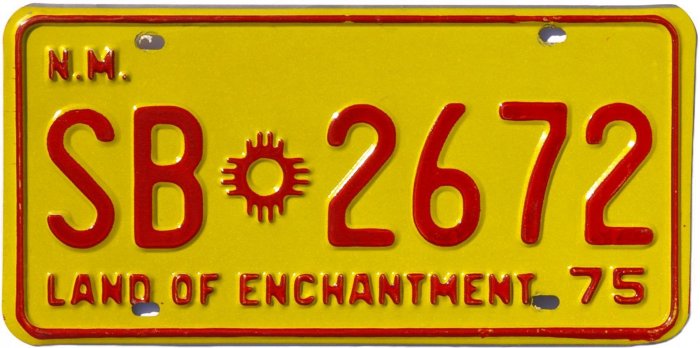 |
| |
School Bus. In the four years
prior to the 1975 redesign of non-passenger plates, School Buses used
the white-on-reflective-green 1971 base, subsequently revalidated for
the three following years with “BUS” stickers. This was a pattern almost
identical to that of several other types, including Truck, Farm Truck,
Commercial Bus, Taxi and Trailer. From 1939 through 1974, School Bus
plates had a serial number prefix of “S,” changing to “SB” upon the
introduction of
the red-on-yellow 1975 tags. The serial number format was further
modified by the introduction of leading zeroes on serials of three
digits or less, with the DMV showing a serial number range of SB-0001 to
SB-5000. For more information on this type, please see the
School Bus page. |
| |
| |
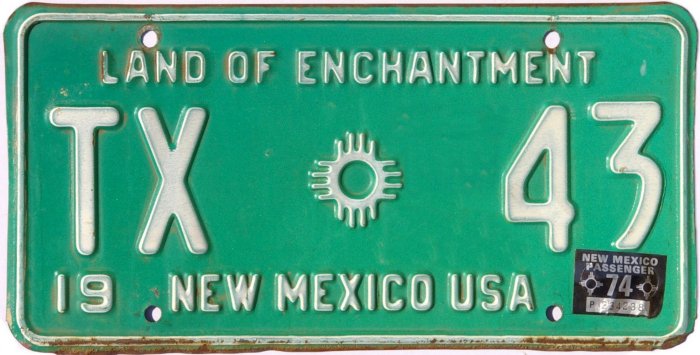
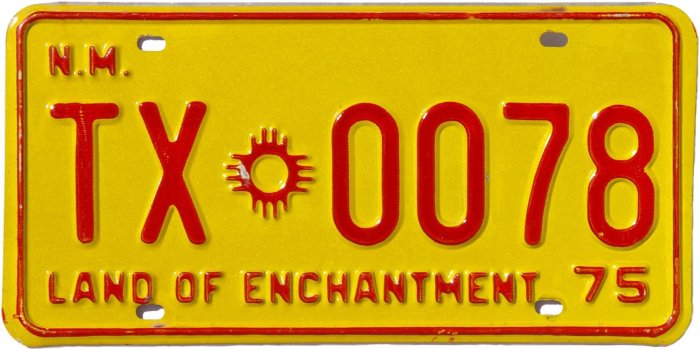 |
| |
| Taxi. Coming out of a four-year
period using the 1971 white-on-reflective-green base plate and 1972-1974
revalidation stickers, the new red-on-yellow plates for 1975 used a
serial number configuration identical to the earlier plates except for
the introduction of leading zeroes where necessary. The 1975 MVD
pamphlet gave no serial number range for the new Taxi plates, but a
similar 1984 pamphlet reported that these had a range of TX-0001 to
TX-0500. Part of these plates were undoubtedly produced after the
publication of the 1975 pamphlet. For more information on this type,
please see the Taxi page. |
| |
| |
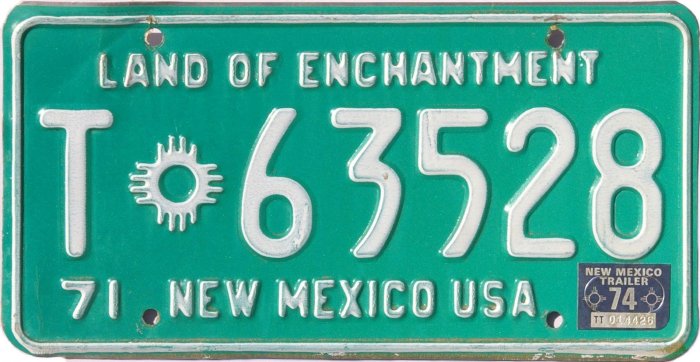
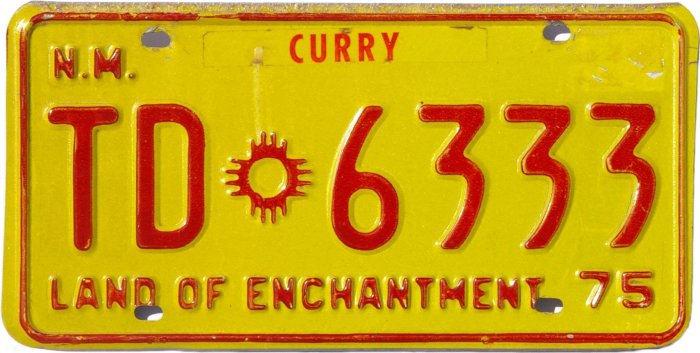 |
| |
Trailer plates were yet another
of the several types which used the 1971 white-on-reflectivegreen base
plate and 1972-1974 revalidation stickers in the four years prior to the
1975 redesign. A single-letter prefix of “T” had been in use since 1955,
but was now changed to a 2-letter prefix beginning with “T” for the new
red-on-yellow plates. The second letter was in alphabetical order
beginning with “A,” such that the reported series issued were TA-0001 to
TA-9999, followed by
the same numerical series prefixed with TB, TC, TD, TE and TF. For more
information on this type, please see the
Trailer page. |
| |
| |
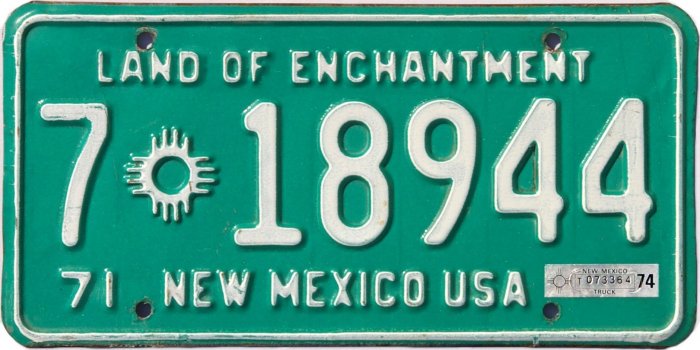
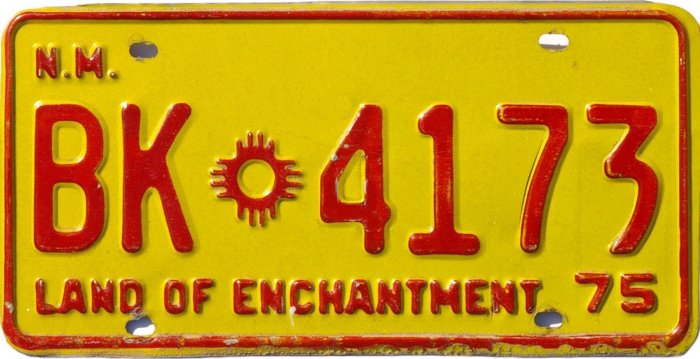 |
| |
Truck. This type’s 1975
incarnation was a landmark change in every respect of its design. Gone
was the county code, and in its place was the 2-alpha/3-numeric serial
number configuration of AA-0000, which was used until truck plates as a
unique type were discontinued in 1991. (From that point to the present
day light trucks have received the same plates as passenger cars.) And
of course the white-on-reflective-green motif now became red on yellow.
The 1975 MVD pamphlet
reported that the series issued were: AA-0001 to AA-9999, and then the
same numerical sequence with AB, AC, AE, AF, AG, AH, AJ, AK, AN, AP, AW,
AX, AY, AZ, BB, BC, BF, BG, BH, BJ, BK, BN, BP. Interestingly, the same
publication reported that plates AC-0001 to AC-0100 had been stolen!
(The absence of certain letter pairs is not explained, but it is known
that New Mexico avoided the use of such letters as I, O, Q, U and V
because of the possibility of confusion with other letters and/or
numerals.) For more information on this type, please see the
Truck page. |
| |
| |
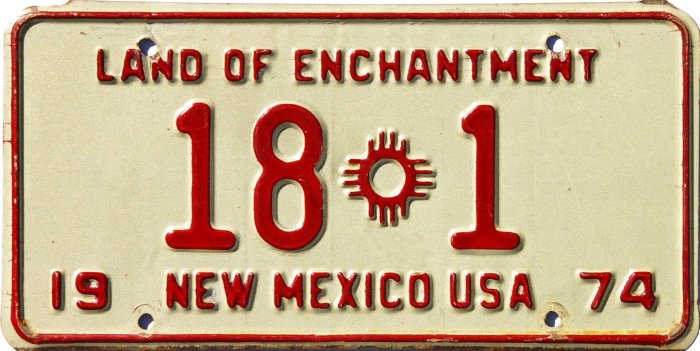
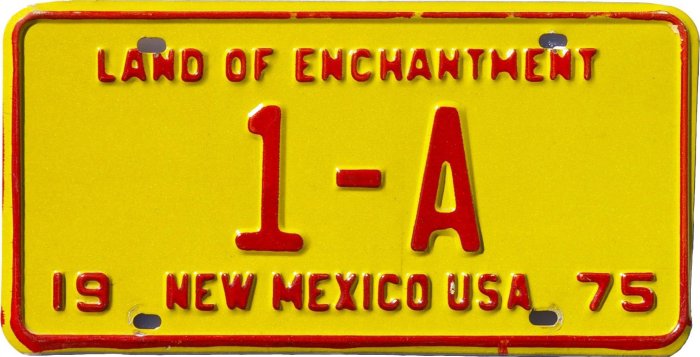 |
| |
| Vanity plates were among the
least affected by the 1975 redesign, and other than the color change
from red on reflective white to red on reflective yellow, there is
essentially nothing to differentiate the 1974 issue from that of 1975.
For more information on this type, please see the
Vanity page. |
| |
| |
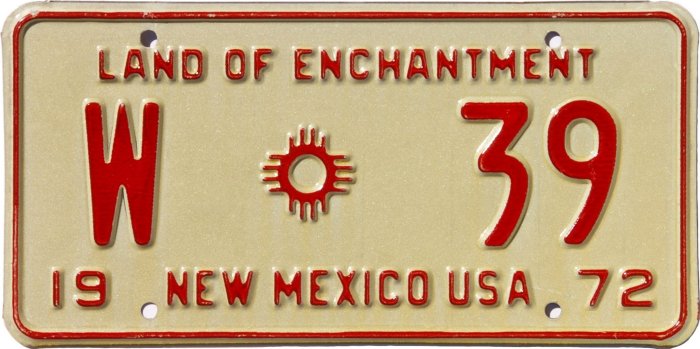
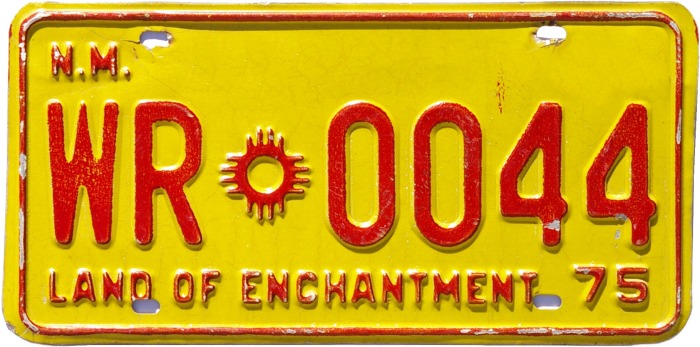 |
| |
| Wrecker plates are
excruciatingly difficult to find, something that can be inferred from
the exceptionally low serial numbers on all the known surviving
examples. Indeed, the 1975 MVD pamphlet states that 1975 Wrecker plates
were issued only from WR-0001 to WR-0075. We do show here the 1975
version, but as there is no known surviving example for 1974, we
illustrate one from 1972. Based on the latter’s similarity to Dealer,
Vanity and Amateur Radio for 1972-1974, all of which are red on
reflective white, the conjecture is that Wrecker plates for 1974 were
likely the same. For more information on this type, and for insight into
their scarcity, please see the Wrecker
page. |
| |
| |


.jpg)
